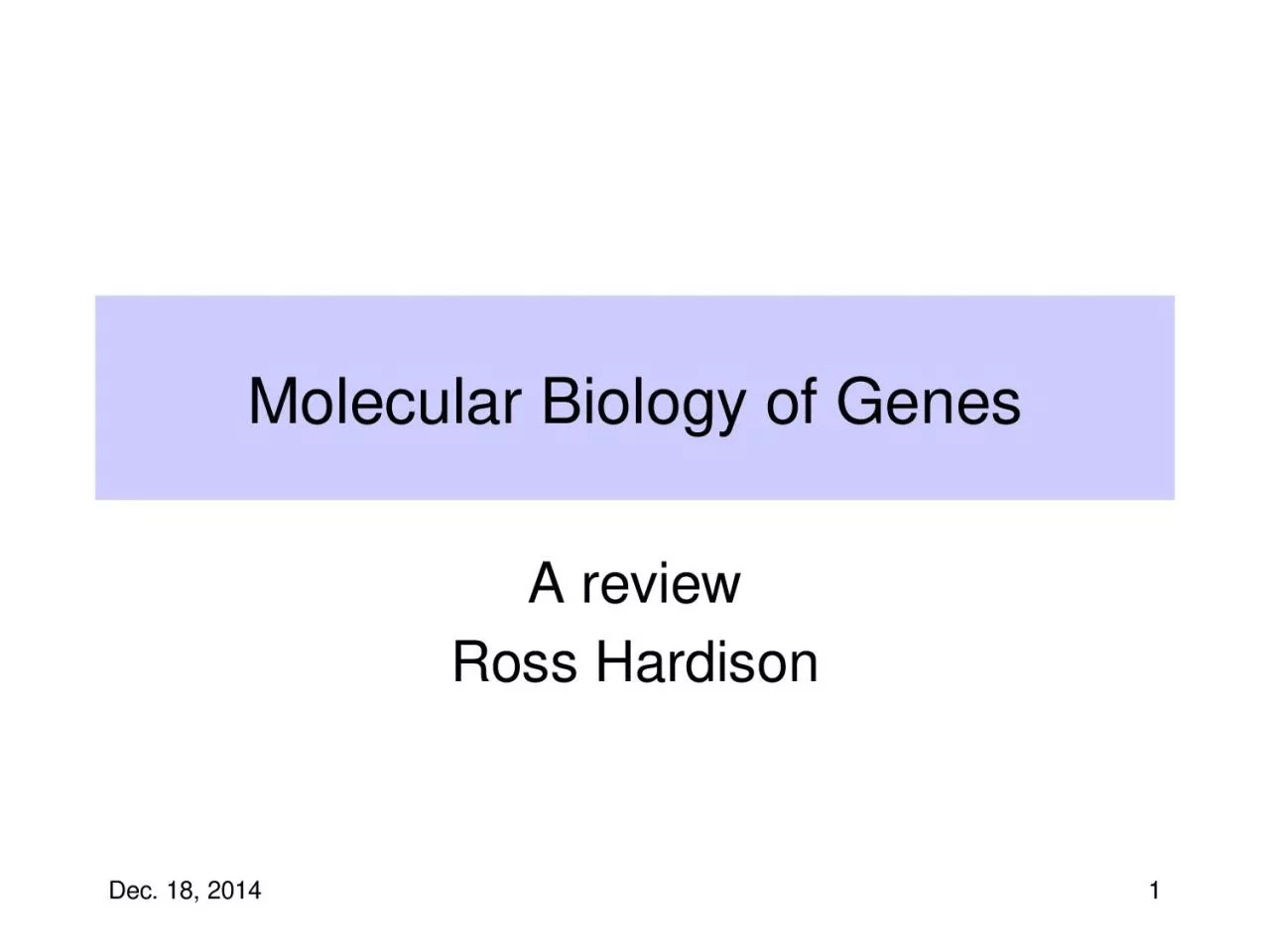

A review Ross Hardison Dec 18 2014 1 What are genes Dec 18 2014 2 Characteristics of Genes Units of heredity Determine heritable phenotypes Are mutable allelic variants Are on chromosomes ID: 1010010
Download Presentation The PPT/PDF document "Molecular Biology of Genes" is the property of its rightful owner. Permission is granted to download and print the materials on this web site for personal, non-commercial use only, and to display it on your personal computer provided you do not modify the materials and that you retain all copyright notices contained in the materials. By downloading content from our website, you accept the terms of this agreement.
1. Molecular Biology of GenesA reviewRoss HardisonDec. 18, 20141
2. What are genes?Dec. 18, 20142
3. Characteristics of GenesUnits of heredity Determine heritable phenotypes Are mutable: allelic variantsAre on chromosomesBehavior of genes mimics movement of chromosomesAllelic variants segregate equally (1st Law)Different genes usually sort independently (Mendel’s 2nd Law) Linked on chromosomes in a linear arrayDec. 18, 20143
4. Types of allelesWild type: normal, functional productLoss-of-function: usually recessiveNull: No productHypomorph: Less productGain-of-function: usually dominantNew functionHypermorph: More productDominant negative: mutant product interferes with function of wild-type productSome alleleic variants have no observable effectsDec. 18, 20144
5. Genes are composed of nucleic acids (usually DNA)Pneumococcus can be transformed from an avirulent to a virulent strainDNA is the transforming principleDNA in bacteriophage particles appears in the progeny, but very little protein does.Dec. 18, 20145
6. DNA is the transforming principleDec. 18, 20146
7. DNA is the transforming principleDec. 18, 20147
8. Structures of nucleic acidsNucleotidesDNA structuresDec. 18, 20148
9. A simple view of DNAAGCCTCGCATTCGGAGCGTA5’5’Anti-parallel strands Reverse complementDec. 18, 20149
10. Nucleotides3 components to nucleotides:Purine or pyrimidine baseRibose (RNA) or 2-deoxyribose (DNA) sugar PhosphateBase + sugar = NucleosideBase + sugar + phosphate = NucleotideDec. 18, 201410
11. Types of bases in nucleotidesPyrimidinesAmino-Keto-Dec. 18, 201411
12. Nucleotides: purine bases6-aminopurineA keto-purineDec. 18, 201412
13. Bases are attached to C1’ of the sugar via an N-glycosidic bond2’-deoxyadenosine, a nucleosideDec. 18, 201413
14. Phosphate is attached to C5’ of the sugar 1st phosphate is a phosphoester, others are attached as phosphoanhydrides.abgDec. 18, 201414
15. Structure of a dinucleotideThe 3’ C of one nucleotide is linked to the 5’ C of the next nucleotide in a phosphodiester linkage.Dec. 18, 201415
16. Nucleic acids are linear chains of nucleotidesThe 3’ C of one nucleotide is linked to the 5’ C of the next nucleotide.The linkage is by a phosphoester.The chain has an orientation defined by the sugar-phosphage backbone.One terminal nucleotide has a “free” 5’ end, and the other has a “free” 3’ end.Thus we designate orientation by 5’ to 3’.Dec. 18, 201416
17. Duplex DNADec. 18, 201417
18. Complementarity of two strands of DNADuplex DNA has 2 complementary strandsComplementarity is based on H-bonding betweenKeto bases with amino basesPyrimidines with purinesA pairs with T (or U)G pairs with CDec. 18, 201418
19. Duplex DNATwo strands coil around each other.Right-handed coils.Coils form major and minor grooves.Strands have opposite polarity (antiparallel).Opposing bases in strands are complementary.Sugar-phosphate backbone is on the outside, bases on the inside Dec. 18, 201419
20. Implications of complementarityOne chain (strand) of DNA can serve as the template for synthesis of the complementary chain.DNA replication: sequence of nucleotides in one chain of the duplex determines the sequence of nucleotides in the other chain.Transcription: sequence of nucleotides in one chain of the duplex determines the sequence of nucleotides in mRNA or its precursor. Dec. 18, 201420
21. More on orientation of chains of nucleic acids5’ACTG 3’ is different from 3’ ACTG 5’Unless specified otherwise, a chain is written with the 5’ end on the left and the 3’ end on the right.When complementary strands in DNA are written, usually the top strand is written 5’ to 3’, left to right, and the bottom strand is written 3’ to 5’, left to right.5’ GATTCGTACCG3’ CTAAGCATGGCDec. 18, 201421
22. Central Dogma of Molecular BiologyDec. 18, 201422
23. Untranslated sequences are at the ends of mRNADec. 18, 201423
24. Only one strand of duplex DNA codes for a producttranscriptiontranslationDec. 18, 201424